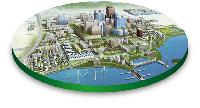
India has the second largest urban population in the world and by 2050, around 50% of India’s population ie., 814 million is expected to live in urban areas.
Given this scenario, the present infrastructure and amenities in cities and towns are not adequate to address the expanding urbanization process.
Several initiatives were launched by the government to promote urban infrastructure in the country. Major initiative is the twin effort of Smart Cities Mission and the AMRUT scheme.
(1) The Smart Cities Mission
The Smart Cities Mission is a major urban renewal program launched by the Government to develop and upgrade living conditions and infrastructure in selected 100 cities all over the country.
Objective of the programme is to modernize cities by providing core infrastructure and give a decent quality of life to its citizens, a clean and sustainable environment and application of ‘Smart’ Solutions. The programme was officially launched on 25th of June 2016 and in the first phase, 20 cities will get funding for converting them into smart cities. In the next two years, the remaining cities will also participate in the project. Ministry of Urban Development is the anchoring agency for the implementation of the project.
The main focus of the project is the area based development of cities by transforming existing areas through retrofitting and redevelopment. Another component of the smart cities project is the development of new areas or greenfield areas. Similarly, adoption of Smart Solutions with the use technology, information and data are expected to improve infrastructure and services under the project.
Financing of smart cities mission
Financing of the mission will be collaboratively done by the Centre, state and local bodies. Fund from the private sector will be invited and Public Private Partnerships will support the project financially.
The most vital contribution will be provided by the centre as it will provide Rs. 48,000 crores over five years i.e. on an average Rs. 100 crore per city per year. Matching the center’s contribution, an equal amount will be made by the State/ULBs. Altogether nearly one lakh crore rupees from government sources will be available for Smart Cities Project. For the implementation of the project each city should form a dedicated Special Purpose Vehicle (SPV).
(2) Atal Mission for Rejuvenation and Urban Transformation (AMRUT) Project
Atal Mission for Rejuvenation and Urban Transformation (AMRUT) along with smart cities were jointly planned and launched by the government to transform urban living conditions through infrastructure upgradation. AMRUT is aimed at transforming 500 cities and towns into efficient urban living spaces over a period of five years. Ministry of Urban Development has selected the five hundred cities with the help of state governments.
A project oriented development approach is adopted under the scheme in contrast to the area based approach of Smart Cities Mission. The Cabinet approved Rs 50,000 crore for this mission which is to be spent over a period five years. This is a centrally sponsored scheme with 80% budgetary support from the Centre.
Mission of AMRUT is to (i) ensure that every household has access to a tap with assured supply of water and a sewerage connection; (ii) increase the amenity value of cities by developing greenery and well maintained open spaces (e.g. parks); and (iii) reduce pollution by switching to public transport or constructing facilities for non-motorized transport (e.g. walking and cycling).
(3) Pradhan Mantri Awas Yojana (Urban) or Housing for All by 2022 Mission
The ‘Housing for All by 2022’ under the scheme of “Pradhan Mantri Awas Yojana – Housing for All (Urban)” launched by the central government aims to provide housing to all urban people by 2022. It provides central assistance to States and UTs for constructing houses to all eligible sections by concentrating on urban slums and economically weaker sections. Hence, slum rehabilitation and affordable housing to Economically Weaker Sections are the major features of the project.
The programme has following components: –
a) Slum rehabilitation of Slum Dwellers with participation of private developers using land as a resource;
b) Promotion of Affordable Housing for weaker section through credit linked subsidy;
c) Affordable housing in partnership with Public & Private sectors and
d) Subsidy for beneficiary-led individual house construction or enhancement.
(4) Heritage City Development and Augmentation Yojana (HRIDAY)
The HRIDAY scheme is launched fro the holistic development of heritage cities. It amis to preserve and revitalize the unique character of heritage cities in India. for the first phase of the programme Rs , 500 crore is allocated with full funding by the central government. Twelve cities—including Ajmer, Amaravati, Amritsar etc are identified for the project.
(5) Jawaharlal Nehru National Urban Renewal Mission
JNNURM was launched in 2005 as the flagship scheme for urban development. The programme had two components viz., Basic Services for Urban poor (BSUP) and Integrated Housing and Slum Development Programme (IHSDP). Civic amenities were improved under the programme including urban transportation. The programme aimed at integrated development of slums through projects for providing shelter, basic services and other related civic amenities.
(6) Urban transportation
Several initiatives were taken to enhance public transport system including the Bus Rapid Transit Systems (BRTS) approved for 11 cities under the Jawaharlal Nehru National Urban Renewal Mission (JNNURM). The transportation system will be equipped with Intelligent Transport System (ITS) and Metro Rail Projects.
(7) Swachh Bharat Mission (SBM)
A major associated urban development programme is making India’s urban centres clean. For this, the SBM targets to achieve 100 per cent scientific management of municipal solid waste in 4041 statutory towns/ cities in the country by 2019.
Besides the above initiatives, several associated development programmes like industrial corridors, NHDP, Jawaharlal Nehru National Urban Renewal Mission, National Urban Livelihood Mission etc., aims to add infrastructure and other amenities to the urban areas.
*********









